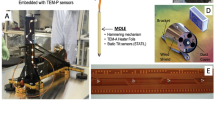Abstract
The NASA InSight mission will provide an opportunity for soil investigations using the penetration data of the heat flow probe built by the German Aerospace Center DLR. The Heat flow and Physical Properties Probe (HP3) will penetrate 3 to 5 meter into the Martian subsurface to investigate the planetary heat flow. The measurement of the penetration rate during the insertion of the HP3 will be used to determine the physical properties of the soil at the landing site. For this purpose, numerical simulations of the penetration process were performed to get a better understanding of the soil properties influencing the penetration performance of HP3. A pile driving model has been developed considering all masses of the hammering mechanism of HP3. By cumulative application of individual stroke cycles it is now able to describe the penetration of the Mole into the Martian soil as a function of time, assuming that the soil parameters of the material through which it penetrates are known. We are using calibrated materials similar to those expected to be encountered by the InSight/HP3 Mole when it will be operated on the surface of Mars after the landing of the InSight spacecraft. We consider various possible scenarios, among them a more or less homogeneous material down to a depth of 3–5 m as well as a layered ground, consisting of layers with different soil parameters. Finally we describe some experimental tests performed with the latest prototype of the InSight Mole at DLR Bremen and compare the measured penetration performance in sand with our modeling results. Furthermore, results from a 3D DEM simulation are presented to get a better understanding of the soil response.















Similar content being viewed by others
Change history
10 July 2017
An erratum to this article has been published.
References
A.J. Ball, R.D. Lorenz, Penetrometry of extraterrestrial surfaces: a historical overview, in Penetrometry in the Solar System, ed. by N.I. Kömle, A.J. Ball, R.D. Lorenz (Austrian Academy of Sciences Press, Vienna, 1999), pp. 3–23
H. Hansen-Goos, M. Grott, R. Lichtenheldt, C. Krause, T.L. Hudson, T. Spohn, Predicted penetration performance of the InSight HP3 Mole, in 45th Lunar and Planetary Science Conference, (2014). Contribution No. 1325.pdf
N.-I. Kömle, J. Poganski, G. Kargl, J. Grygorczuk, Pile driving models for the evaluation of soil penetration resistance measurements from planetary subsurface probes. Planet. Space Sci. 109–110, 135–148 (2015)
R. Lichtenheldt, B. Schäfer, O. Krömer, Hammering beneath the surface of Mars—modeling and simulation of the impact-driven locomotion of the HP3-Mole by coupling enhanced multi-body dynamics and discrete element method. 58th Ilmenau Scientific Colloquium, Technical University Ilmenau (Germany), 08–12 September 2014, URN:urn:nbn:de:gbv:ilm1-2014iwk:3
R. Lichtenheldt, O. Krömer, Soil modeling for InSight’s HP3-Mole: from highly accurate particle-based towards fast empirical models, in ASCE Earth and Space 2016, ASCE E&S 2016 (2016)
ÖNORM B4435-2:1999-10-01, Austrian Standard for Spread Foundations in Geotechnical Engineering
K. Seweryn, J. Grygorczuk, R. Wawrzaszek, M. Banaszkiewicz, M. Rybus, L. Wisniewski, Low Velocity Penetrometers (LVP) driven by hammering action—definition of the principle of operation based on numerical models and experimental tests. Acta Astronaut. 99, 303–317 (2014a)
K. Seweryn, K. Skocki, M. Banaszkiewicz, J. Grygorczuk, M. Kolano, T. Kucinski, J. Mazurek, M. Morawski, A. Bialek, H. Rickman, R. Wawrzaszek, Determining the geotechnical properties of planetary regolith using low velocity penetrometers. Planet. Space Sci. 99, 70–83 (2014b)
E.A.L. Smith, Pile driving analysis by the wave equation. Am. Soc. Civil Eng. (ASCE) Trans. 127, 1145–1193 (1962)
T. Spohn, K. Seiferlin, A. Hagermann, J. Knollenberg, A.J. Ball, M. Banasczkiewicz, J. Benkhoff, S. Gadomski, J. Gregorczyk, J. Grygorczuk, M. Hlond, G. Kargl, E. Kührt, N. Kömle, J. Krasowski, W. Marczewski, J.C. Zarnecki, MUPUS—a thermal and mechanical properties probe for the Rosetta Lander Philae. Space Sci. Rev. 128, 339–362 (2007)
T. Spohn, M. Grott, J. Knollenberg, T. Van Zoest, G. Kargl, S.E. Smrekar, W.B. Banerdt, T.L. Hudson, The HP3 Instrument Team InSight, Measuring the Martian heat flow using the heat flow and physical properties package, in 43th Lunar and Planetary Science Conference (2012). Contribution No. 1445.pdf
K. Terzaghi, Theoretical Soil Mechanics (Wiley, New York, 1943)
C. Yana, L. Kerjean, A. Sylverstre-Baron, J. Baroukh, M. Nonon, P. Laudet, S. Weinstein-Weiss, L. Morales, A.M. Aguinaldo, L. Dubon, P. Lognonne, D. Mimoun, Operations of the SEIS seismometer onboard the 2016 InSight mission, in Proceedings Space Ops 2014 Conference, 5–9 May 2014, Pasadena, CA, American Institute of Aeronautics and Astronautics (2014)
Acknowledgements
The authors are grateful to the Austrian FFG (Forschungs-Förderungs-Gesellschaft) for supporting this research in the frame of its ASAP10-program under the Project InSight-MPS (Modeling of Dynamic Penetration in Granular Soils under Space Conditions).
Author information
Authors and Affiliations
Corresponding author
Additional information
This article has been updated because during article processing an error occurred in the article title and in one of the author’s names. Both instances “HP3” in the article title and author “José E. Andrade” have been corrected in this article and should be regarded as final version by the reader.
An erratum to this article is available at https://doi.org/10.1007/s11214-017-0397-x.
Rights and permissions
About this article
Cite this article
Poganski, J., Kömle, N.I., Kargl, G. et al. Extended Pile Driving Model to Predict the Penetration of the Insight/HP3 Mole into the Martian Soil. Space Sci Rev 211, 217–236 (2017). https://doi.org/10.1007/s11214-016-0302-z
Received:
Accepted:
Published:
Issue Date:
DOI: https://doi.org/10.1007/s11214-016-0302-z




